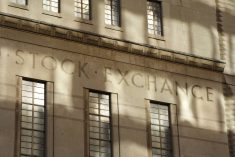There is an old saying that you can’t beat the market. Famed investor Warren Buffett has said, “Mr. Market always wins.” One school of investing agrees that, given you can’t beat the market, you might as well join it. That is the birth of index investing: the concept of buying index funds packed in exchange traded funds. They are sold like stocks, priced every moment of the trading day and almost always have rock bottom management fees. The question is, for off-farm investors, is it wise to put money into them?
Read Also

Gentle treatments for pain in the neck
Heading toward year-end, people unknowingly tense up against the cold and busyness, causing neck pain that can often be treated with appropriate support and gentle mobility, athletic therapist Kathlyn Hossack says.
Index investing
The choices of index funds are vast. There are about 20,000 exchange-traded fund (ETF) index followers, including those that shadow the Dow Jones Industrial Average, the Standard & Poor’s 500, the Wilshire 5000 (a broad U.S. index which covers almost all small and large cap stocks traded in the U.S.), numerous European and Asian indices and the biggest wrapper of all, the MSCI World Index. You can buy index ETFs that mimic European pharmaceutical company shares or small cap companies in India. There are about as many ETFs as all the shares listed in the whole world. The problem is to make sense of them.
It’s about making money, so let’s look at some returns. For example, the iShares S&P/TSX 60 Index ETF, trading symbol XIU, has a management expense ratio of 0.18 per cent and a 7.07 per cent average annual return since inception in September, 1999, slightly less than the benchmark index itself. The reason for the lower return is the fees paid, but that is small — the cost of owning the ETF is far less than the average annual mutual fund fee of about 2.6 per cent. The XIU fund, like the TSX 60 index, is made up of 40 per cent financial stocks and 21 per cent energy stocks, which is a fair description of Canada’s stock market.
Buying shares that represent the whole market can be perilous to your wealth. Consider Nortel Networks shares that were priced at $124.50 in July, 2000. At that time, they made up 35 per cent of the value of the Toronto Stock Exchange. Then Nortel collapsed, dragging down the TSX 60. The value of all stocks on the TSE fell from about 1,200 in mid-2,000 to 6,500 in October, 2002. The Nortel collapse was part of the slide, as was the broad failure of the dot com boom. The point of this vignette is that index investing doesn’t work if you pick the wrong index.
The concept of index investing is diversification, which is a good thing. The downfall of index investing is when an index is not diversified. The Finnish index was overweighted with shares of cellphone maker Nokia. As the respected tech publication Wired noted on October 4, 2013, “by 2013, Nokia accounted for 70 per cent of Helsinki’s stock exchange market capital, 43 per cent of all Finnish corporate R&D, 21 per cent of total exports and 14 per cent of corporate tax revenues. That dominance of a stock exchange was and still is unprecedented. The Finnish stock index could not have been said to have been diversified by any stretch of the imagination. The same problem exists in the weight of brewer AmBev on the Brussels exchange, the weight of bank Santander and telco Telefonica on the Madrid board, and banks on the Paris bourse. In short, diversification among industries is not always achieved by indexing.
Let’s take another example, this time the widest index ETF of all. That’s the Morgan Stanley Capital International (MSCI for short) World Index ETF. As of October, 2017, it’s 58.9 per cent U.S. stocks by value. It is not so much a world index as a U.S. index with a scattering of other national markets.
Cap-weighted indexes are based on capitalization — the number of shares outstanding times the share price of each stock. The unfortunate characteristic of these indexes is that the stocks with the biggest capitalization get the biggest weight in the index. If you buy one of these cap-weighted indices, you are buying the winners. The higher the share price and the more shares outstanding, the bigger the capitalization. That is the opposite of what most investors want: a chance to buy low.
If you want less risk than the benchmark index, seek out a low volatility ETF. If you want more growth and don’t mind the extra rollercoastering, go for a growth index. .
There is another issue with index fund investing. Index funds, which by definition are fully invested, hold no cash. So when markets are on the way up, index funds will tend to beat managed mutual funds which tend to hold cash in order to buy stocks or bonds when they seem good deals and to provide funds for redemptions. On the way down, index funds with no cash cushion, will tend to fall more than managed funds with their cash cushions.
Moderation of index moves is a potential virtue of cash-cushioned mutual funds, but how well that works in relation to pure index investing is murky.
The problem is to compare indexes, which are public and lay bare their entire numerical history, with mutual funds, which can conceal their history. This issue is called survivor bias.
If a mutual fund has a dreadful record, its management company can merge it into one of its successful funds. The surviving fund, which has absorbed the loser, now has more money under management, which makes it look good, and the record of the loser is buried.
Then there is the problem of continuity. The same funds are not always the best performers. If you set aside the funds in the top fourth of performance, the first quartile in fund speak, five years later only half the original lot is still in the first quartile. Another five years on and now half of the first fourth are leading in the first quartile. Another five years and half of that lot remain in the first quartile. Fund profitability is random, not based on skill.
To this problem, fund manager and math whiz Ted Aronson, adds that it can take between 16 and 75 years to provide that a manager’s returns are the result of skill to a confidence level of just 75 per cent. The 95 per cent level of certainty can take up to a millennium. Jason Zweig, a very respected financial writer concludes that picking investment funds based only on their past performance is, we’ll quote here, “one of the stupidest things an investor can do.”
What can you do?
If index funds are biased on the way up and overloaded with winners while managed mutual funds can be winners one day and clunks the next, what to do? I’d suggest following three rules:
Rule 1: Diversify inexpensively. Index investing is imperfect, but index ETFs do provide diversification at very low cost. Low management fees are a cushion against losses in more expensive funds. U.S. broad market index ETFs replicate the S&P500 and the Dow Jones Industrial Average and many other indices. You can also find equally-weighted index ETFs that reduce a stock like Apple Inc. from about 11.5 per cent of the NASDAQ 100 Core Index to 1/100th of the total value of the index. Even if Apple, which is 58 per cent of the index in raw form, were to evaporate, the direct loss to the index would be at most one per cent. This is because the equally-weighted index gives each one of the 100 stocks in the NASDAQ equal weight.
Rule 2: Use ETFs when trading costs are very high. It is tough to buy small lots of bonds inexpensively. Banks and other dealers sell them as principals and want profits, not as agents just charging commissions. In a bond index fund, you get pricing every moment of the trading day, you can sell any time you like, you can slice off any amount you like, and trading costs are low.
Rule 3: If you choose to buy individual stocks, get an edge by focusing on industries you understand. Farmers have an edge when buying Deere & Co., for example. Bank on your knowledge when you have an inside track.















